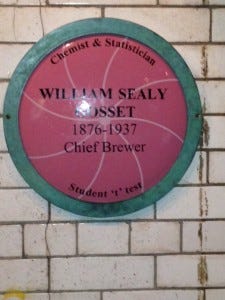Guinness: An Irish Water Rights Story
Dateline: Kilronan Castle, Ireland
The water crowd should visit the Guinness Storehouse in Dublin, Ireland. The legacy will strike a familiar theme:
established water rights lead to business development and economic expansion
The Beginning
Arthur Guinness was born in 1725 in county Kildare, Ireland. His father was Land Steward to the Archbishop of Cashel, whose duties included supervising the brewing of beer for estate workers. The Archbishop (Arthur’s godfather) left Arthur £100 in his will. He used the bequest to run a small brewery nearby in Leixlip.
In 1759, Arthur gave the brewery to a younger brother and sought new challenges in Dublin, Ireland’s Capital. Irish beer suffered from English discriminatory taxation (ring a bell Americans?). Arthur was undeterred. He acquired a small, disused brewery at Saint James Gate. He signed a 9,000-year lease at an annual rate of £45 (unescalated).
Water War
The next part of his saga warrants full quotation from the Guinness Archive:
“Arthur Guinness was a determined man, particularly in defence of his rights. The brewery lease granted him free access to a water supply. In 1775 the Dublin Corporation tried to make him pay for this access by sending the sheriff with a body of men to cut off his water source. Arthur responded vigorously by seizing a pick-axe from one of the men and declaring ‘with very much improper language that they should not proceed’. He won his point and the brewery maintained its vital free water supply.”
In 1784, Arthur signed a 8,795-year lease where he agreed to pay an extra £10 annually for use of water.
Continuous water supply
The Storehouse’s exhibit hall has a section on water. It mentions Arthur’s vigilant protection of his water rights and water quality from sources in nearby mountains.
Economic Expansion
The brewery’s success was built on active protection and management of water (see above), barley, hops and yeast. Arthur invested in the use of science. Guinness’s chief chemist and statistician, William Sealy Gosset developed the “T-Test” (remember stat class?) as a cheap way to check the quality of stout. Mr. Gosset’s pen name was “Student”.
Better management through statistics
Research also developed proprietary recipes for use of ingredients, including development of a specialized yeast strain. The yeast used today is a replica of the version perfected centuries ago. A sample is used in each batch to generate the same strain for future batches. A culture of the yeast is stored in a director’s safe. In the event that the yeast in production facilities were destroyed, the back-up culture can be tapped in an emergency.
Would these investments be made without a secure and long-term water supply?
The combination of secure water and initiative generated an Irish juggernaut. By 1833, Guinness was the largest Irish brewer. In 1886, Guinness became the first major brewer to become publicly incorporated and listed on the London Stock Exchange. It was then the largest brewer in the world with an annual production of 1.2 million barrels. Growth continued. In 2007, Guinness sold an estimated 10 million glasses worldwide daily in over 150 countries. Guinness exports have of its production.
The family retained control of Guinness (a remarkable multi-generational achievement) until the 1980s when a non-family member became CEO. The company also bought out the long-term lease of land and water in this time period. (Hydrowonk research has yet to uncover the terms of the buyout.) In 1997, Guinness merged into the Diaego Group.
The economic success of Guinness is a key to the Irish economy. Guinness purchases about 75% of Ireland’s barley production (an important boon to the rural island economy). Guinness is also an engine of employment. On the eve of World War I, Guinness employed more than 3,420 with about 10,000 people dependent on their livelihood—or 1 in 30 of Dublin’s population. By the 1930’s, Guinness employed 12,000 in Dublin, about 10% of the male population. (The full economic impact, of course, must trace back to the business support of agriculture and other related services.) After World War II, Guinness opened breweries throughout the world. This transformation into an international company has reduced Guinness’s footprint in Ireland. Today, corporate offices are in London.
The Legacy
Any successful capitalist venture springs controversy. See a 2003 essay by Sean Dune for a counterpoint. The Irish have issued a verdict. Since 2009, there is national celebration of Arthur Guinness Day where an evening of music, festivities and (of course) drink celebrates Arthur and his contribution to Ireland. At 17.59 local time last Thursday on “Arthur Guinness Day”, all raised their glass of Guinness and toasted his legacy.
All this started with a long-term water supply!



